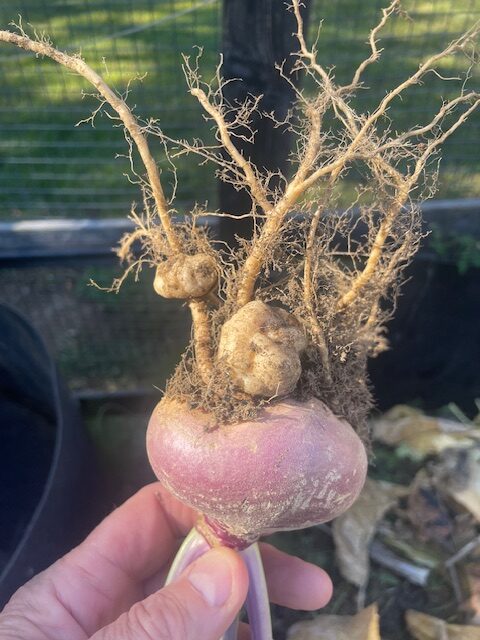Notes to track various pests and pathogens and their treatment. This includes insects, disease and critters.
| Months | First Sighting | Pest/ Pathogen | Crop | Prevention /Treatment | Signs/ Comments |
|---|---|---|---|---|---|
| May | none | Leaf minor | Spinach & beets | row cover with blue sticky trap | successfully prevented it |
| June- | Cabbage worms | Cabbage | Hand removal (multiple passes each week) | Frass, holes in leaves | |
| July-Aug | 7/12 – brussels 7/12 – nasturtiums 7/12 – dino kale 8/9 – curly kale | Aphids | Brussels, nasturtiums, dinosaur kale, curly kale | Insecticidal soap; don’t use on fava beans, damages the blossoms | |
| July-Aug | 7/12 | Mediterranean fruit fly? | Peppers | Spray neem in evenings | Maggots eating fruit from the inside; tiny dots on outside of pepper |
| Jul-Aug | 7/2 | Squash vine borer eggs | Summer squash, pumpkins, red kuri, mambo, cucumbers, honeynut | Remove eggs with packing tape | small red-ish brown spheres on stems and leaves |
| Jul-Aug | 7/19 – mambo,red kuri, dunja | Squash vine borer larvae | Red kuri, mambo, pumpkin, zucchini | Surgery (small cut in vine where frass is found, sharp tweezers to remove borer) | |
| July-Aug | 7/26 | Squash bug eggs | Winter squash (red kuri, mambo) | Hand remove eggs and bugs | clusters of amber spheres |
| Jul | 7/9 | Black spot | Tomatoes | Serenade fungicide | black spots on tomato leaves |
| Aug | 8/3 | Rodent? | tomato | half-eaten ripe tomato | cover developing fruit with fabric bags |
| Cucumber beetle | ? | ||||
| Aug-Sep | 8/10 | Powdery Mildew | Squashes, jerusalem artichokes, sunflower | Spray with Serenade | White coating on leaves |
| Jul-Aug | mid Jul? | Rust? | Bush Beans | none | Discolored leaves and loss of foliage; try fungicide next year? |
| Sep | 9/20 | club root | rutabaga | none | Large nodules on one rutabaga |
Notes on squashes
- 7/12 – First frass from SVBs found on several plants. Surgery on 3-4 where frass was fresh and sprayed the cut with BT afterwards.
- 7/12 – started spraying leaves with Serenade, a fungicide to prevent powdery mildew
- 7/16 – spray Serenade
- 7/19 – spray Serenade
- 7/26 – clusters of squash bug eggs on the winter squash leaves (underneath). They look like tiny amber beads.
- 7/26 – spray Serenade
- 8/2 – spray Serenade; early signs of powdery mildew on pumpkins
- 8/9 – One mambo and one red kuri plant died from SVBs (these plants had surgery the first week and never fully recovered). The two plants each survived long enough to yield a mature squash. Harvested 2 mature red kuri.
- 8/9 – Possible squash bug damage with leaf wilt – no signs of frass, but clear damage to stem and some black residue.
- 8/9 – spray Serenade; starting to see powdery mildew on some leaves
- 8/17 – another mambo plant died from the SVB damage. Yielded one small but mature mambo
- 8/17 – spray Serenade; powdery mildew on a number of plants
- 8/23 – spray Serenade; trimmed mildewed leaves. Cleared one dead mambo plant. No new signs of SVB damage, but more squash bug eggs


Notes on Peppers
- 7/18 – insect app identified a fly on the peppers as a Mediterranean fruit fly. Possible that the damage to the peppers is from the larvae of these flies? Placed a yellow stick trap near sweet peppers


Notes on Brassicas
- Aphids found on tops of brussels sprouts in July. Spray with insecticidal soap and topped the plants (along with most of the aphids, which colonize in the new top growth, in early August)
- Cabbage worms in the cabbages. Maybe try row cloth to reduce eggs?
- Rutabaga with large nodules on roots ; might be club root which persists in soil for years and could impact other brassicas planted there (bed F, on the side nearest to compost)


Notes on Tomatoes
- Signs of black spots on tomato leaves. Started spraying tomatoes with Serenade (organic fungicide) once per week
- 7/12 – started spraying leaves with Serenade, a fungicide to help combat black spots on leaves
- 7/16, 7/19, 7/26 – spray Serenade
- 8/2 – spray Serenade; three plants succumbing to some sort of disease (green zebra and 2 others)
- 8/16 – critter chewed through a bag to eat one ripe tomato. However, the vast majority of ripe tomatoes that were bagged have been untouched by critters.























Leave a Reply
You must be logged in to post a comment.